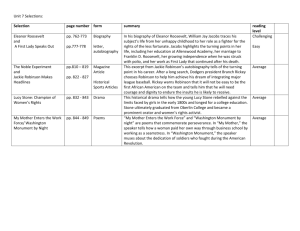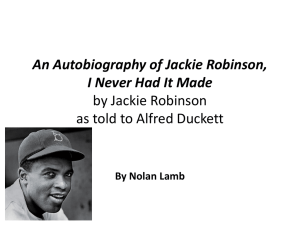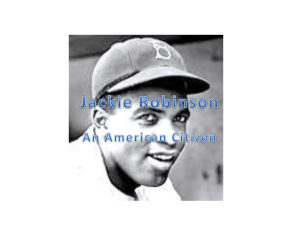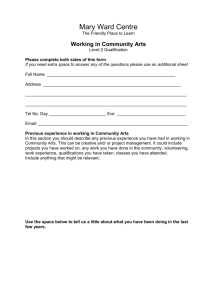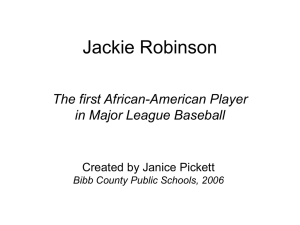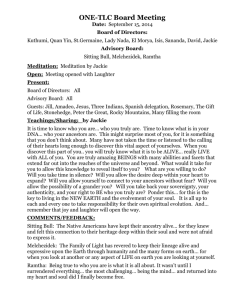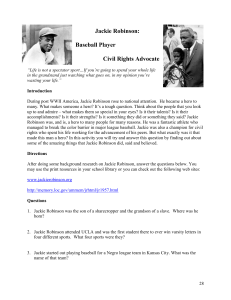Replace This Text With The Title Of Your Learning Experience
advertisement
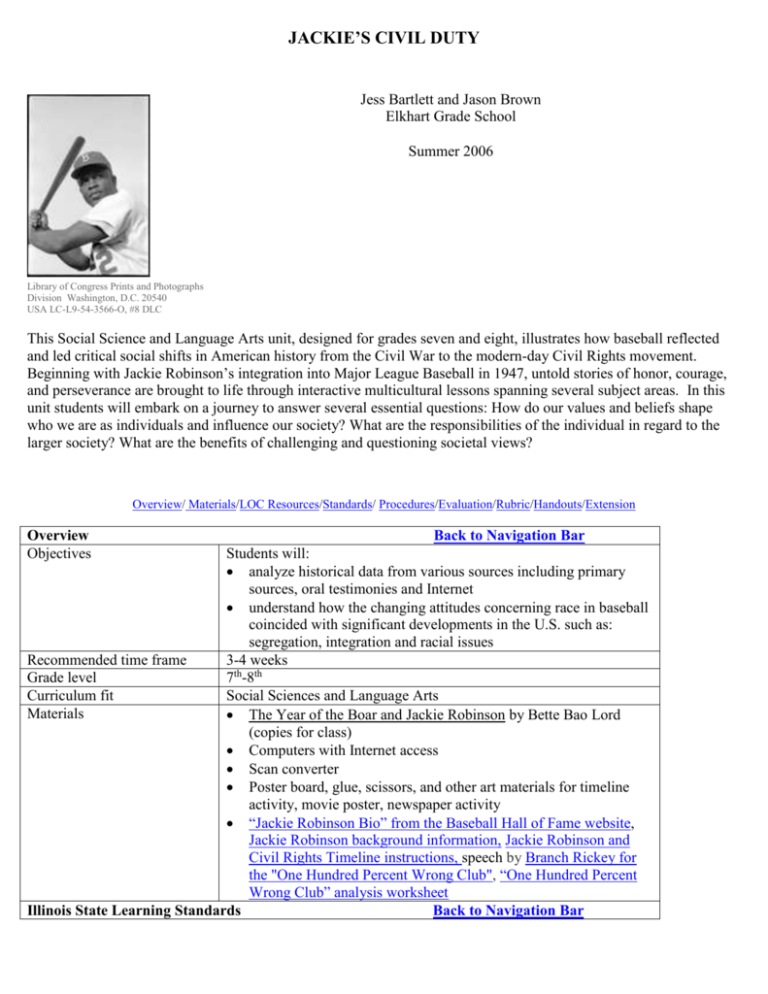
JACKIE’S CIVIL DUTY Jess Bartlett and Jason Brown Elkhart Grade School Summer 2006 Library of Congress Prints and Photographs Division Washington, D.C. 20540 USA LC-L9-54-3566-O, #8 DLC This Social Science and Language Arts unit, designed for grades seven and eight, illustrates how baseball reflected and led critical social shifts in American history from the Civil War to the modern-day Civil Rights movement. Beginning with Jackie Robinson’s integration into Major League Baseball in 1947, untold stories of honor, courage, and perseverance are brought to life through interactive multicultural lessons spanning several subject areas. In this unit students will embark on a journey to answer several essential questions: How do our values and beliefs shape who we are as individuals and influence our society? What are the responsibilities of the individual in regard to the larger society? What are the benefits of challenging and questioning societal views? Overview/ Materials/LOC Resources/Standards/ Procedures/Evaluation/Rubric/Handouts/Extension Overview Objectives Back to Navigation Bar Students will: analyze historical data from various sources including primary sources, oral testimonies and Internet understand how the changing attitudes concerning race in baseball coincided with significant developments in the U.S. such as: segregation, integration and racial issues Recommended time frame 3-4 weeks Grade level 7th-8th Curriculum fit Social Sciences and Language Arts Materials The Year of the Boar and Jackie Robinson by Bette Bao Lord (copies for class) Computers with Internet access Scan converter Poster board, glue, scissors, and other art materials for timeline activity, movie poster, newspaper activity “Jackie Robinson Bio” from the Baseball Hall of Fame website, Jackie Robinson background information, Jackie Robinson and Civil Rights Timeline instructions, speech by Branch Rickey for the "One Hundred Percent Wrong Club", “One Hundred Percent Wrong Club” analysis worksheet Illinois State Learning Standards Back to Navigation Bar Social Sciences Goal 14: Understand political systems with an emphasis on the United States. 14.F.3a Analyze historical influences on the development of political ideas and practices. Goal 16: Understand events, trends individuals and movements shaping the history of Illinois, the United States and other Nations. 16.A.3b Make inferences about historical events and eras using historical maps and other historical sources. Goal 18: Understand social systems with an emphasis on the United States. 18.C.3a Describe ways in which a diverse U.S. population has developed and maintained common beliefs (e.g., life, liberty and the pursuit of happiness; the Constitution and the Bill of Rights). Language Arts Goal 1: Read well with Understanding. 1.C.3a Use information to form, explain and support questions and predictions 1.C.3c Compare, contrast and evaluate ideas and information from various sources and genres Goal 2: Read and understand literature representative of various societies, eras and ideas. 2.B.3a Respond to literary material from personal, creative and critical points of view. Goal 5: Use the language arts to acquire, assess and communicate information. 5.B.3a Choose and analyze information sources for individual, academic and functional purposes 5.B.3b Identify, evaluate and cite primary sources Procedures Back to Navigation Bar Suggested Pre-Program Activities Students will need to bring considerable knowledge to this lesson, including a basic understanding of race relations in the United States, as well as a more specific understanding of the history of race relations after the Civil War. For example the African American struggle during the twentieth century to end segregation and achieve civil rights for African Americans. Websites including Baseball, the Color Line, and Jackie Robinson, Jackie Robinson & Other Baseball Highlights, 1860s-1960s, and Shades of Greatness Exhibit are all helpful in establishing the climate of the United States at the time. Read The Year of the Boar and Jackie Robinson by Bette Bao Lord. After each chapter, discuss what the students learned and felt, as well as key vocabulary terms, and figurative or descriptive language. Students should record individual perceptions in a daily journal. Throughout reading of the book, pay special attention to the racial climate in the United States. Using Library of Congress website, Baseball Hall of Fame website, etc. search as a class for primary source documents about the Negro Leagues. Model using the photo, document and motion picture analysis forms to acquaint students with using primary sources and the features of the forms. Opening Activities Show the short film excerpt titled “Jackie Robinson Bio” from the Baseball Hall of Fame website. Jackie Robinson burst onto the scene in 1947, breaking baseball's color barrier and bringing the Negro leagues' electrifying style of play to the majors. He quickly became baseball's top drawing card and a symbol of hope to millions of Americans. With Robinson as the catalyst, the Dodgers won six pennants in his 10 seasons. He dominated games on the base paths, stealing home 19 times while riling opposing pitchers with his daring base running style. Robinson was named National League MVP in 1949, leading the loop in hitting (.342) and steals (37), while knocking in 124 runs. Using the Jackie Robinson background information, tell the students who Jackie Robinson was and what contributions he has made to our society. Discuss some of the events in his life that may have shaped him to be at the forefront of civil rights. Divide students into groups of four or five and have them discuss within their group what qualities they think helped Jackie the most. Have them present their ideas to the class one group at a time. Lesson One: Timeline Establish the time period by using primary sources to develop a timeline including events in the life of Jackie Robinson and significant events in the area of civil rights. Pass out the Jackie Robinson and Civil Rights Timeline instructions. Working in pairs, students will select 8 primary sources including photos, documents, motion pictures or audio. Students will print out artifacts and must include a description and proper citation on the timeline. Upon completion, partners will present the timeline with a short explanation of the sources and their significance to the life of Jackie Robinson and Civil Rights. Lesson Two: Analysis of Speech by Branch Rickey for the "One Hundred Percent Wrong Club" banquet Display on scan converter and pass out copies of Speech by Branch Rickey for the "One Hundred Percent Wrong Club" banquet, Atlanta, Georgia, January 20, 1956. Broadcast on WERD 860 AM radio. Throughout the speech, discuss the tone, expressions and any unfamiliar language with students. Invite students to express their feelings and thoughts about the speech. Use the following questions to lead a class discussion. In the fourth paragraph of his speech, Rickey seems to be saying that he desired to bring a black player to the St. Louis ballclub. Why did this effort fail? According to Rickey, what were the four factors that were necessary for him to bring a black player to the major leagues successfully? Rickey stated that :the greatest danger, the greatest hazard, I felt was a negro race itself. " What did he mean by that? Rickey stated that according to the historian Frank Tannenbaum, four things were necessary for the acceptance of black players in baseball. What were those four factors When Rickey stated, “I am completely color blind,” do you take him at his word? Do you think that the following statement made by Branch Rickey was true in 1956? America is,--it's been proven Jackie,--is more interested in the grace of a man's swing, in the dexterity of his cutting a base, and his speed afoot, in his scientific body control, in his excellence as a competitor on the field,--America, wide and broad, and in Atlanta, and in Georgia, will become instantly more interested in those marvelous, beautiful qualities than they are in the pigmentation of a man's skin. What did Rickey mean when he referred to “the last syllable in a man’s name”? Pass out the “One Hundred Percent Wrong Club” analysis worksheet. Students complete the analysis individually. Lesson Three: Analysis of Jackie Robinson’s “This I Believe” speech Display on scan converter and pass out copies of “This I Believe” speech. Explain that the speech is part of the The Jackie Robinson Papers collection that can be found on the LOC website. The Jackie Robinson Papers include an extensive speech file that reflects the author’s diverse interest in such topics as baseball, racial equality, politics, religion, drug abuse, and black economic development. In this speech Americans to America’s status as “a free society.” After reading the speech, discuss similarities of the speech to Martin Luther King’s “I Have a Dream” speech. What themes are present in both? What were the goals of both speeches? Who was the target audience? Were the speeches and speakers effective? Concluding Activities Students may choose 1 of the following 3 projects to complete the unit and demonstrate their understanding of Jackie Robinson’s contributions to Civil Rights and baseball. Watch “The Jackie Robinson Story” and complete the motion picture analysis form. Using poster board, create a poster promoting “The Jackie Robinson Story.” Use primary source documents including photos and other interesting artifacts to make Evaluation Extension the poster visually appealing and informative. Poster must include the movie title and important actors. Prepare a short explanation of your poster and answering the following questions about the film: Did it address the difficult situations in Jackie Robinson’s life? Is Jackie Robinson presented as a hero? How many stars out of 4 would you give the movie and why? Look at the following three newspapers related to Jackie Robinson and Civil Rights. Choose 1 of the three newspapers and complete the written document analysis form. Next, design the front page of a newspaper that might have been published in the time of Jackie Robinson. Include 3 events with primary source documents including 1 baseball-related, 1 Civil Rights-related and 1 additional topic. Keep in mind the time period, racial climate and significant topics of concern at the time of the newspapers publishing. Look at the Jackie Robinson documents available at Beyond the Playing Field - Jackie Robinson, Civil Rights Advocate. After reading the 9 documents, students choose 3 documents and complete the Robinson and Civil Rights analysis worksheet Back to Navigation Bar Contributions to the group discussions will be assessed through informal observation during the unit. Evaluation of the timeline in the following areas: 8 sources with descriptions and proper citation, sources relevant to the subject, attractive display of the sources and a short explanation of the timeline events. Contributions to group discussion concerning Rickey speech. Evaluation of the Analysis of Speech by Branch Rickey for the "One Hundred Percent Wrong Club" banquet. Contributions to group discussion concerning “This I Believe” speech. Evaluation of concluding activity considering specific requirements of each project.. Back to Navigation Bar Reading the photograph: select photographs from various primary source websites and complete analysis worksheets. Consider comparing and contrasting baseball stadiums, uniforms and the crowd present. Look for clues to the racial climate in various photographs by answering the following questions: Are the players in these images represented as part of a team or as individual players? What is the appeal of each type of representation? What personal skills or qualities are emphasized in the images? What adjectives would you use to describe the players? How is the baseball player depicted as a hero? What purpose do you think these symbolic images of baseball players have served? How has that purpose changed through time? What are the implications of segregation in baseball when the players are treated symbolically? Read Jackie Robinson’s letter to Ralph Norton. Write a paragraph explaining how this letter is indicative of the racial climate when it was written. Imagine that you are Ralph Norton and write a letter of response. Woodrow Johnson’s 1949 song, "Did You See Jackie Robinson Hit That Ball?" is one of many songs written to honor Jackie Robinson’s on-field accomplishments, but Count Basie’s recording of the piece made it one of the most famous. Johnson’s lyrics provide an opportunity to discuss poetic devices such as rhyme scheme, word choice, and narration. Excerpt from Sheet Music for "Did You See Jackie Robinson Hit That Ball?" Did you see Jackie Robinson hit that ball? It went zoom in cross the left field wall. Yeah boy, yes, yes. Jackie hit that ball. And when he swung his bat, the crowd went wild, because he knocked that ball a solid mile. Yeah boy, yes, yes. Jackie hit that ball. How are Jackie Robinson’s actions described? Does the songs describe a single event in a game or a general description of Robinson’s ability? Why? What is the relationship between Robinson and the crowd? What does the repetition of the rhyme scheme add to the song? How does it reinforce the lyrics? How does this account compare to other songs about baseball players? Choose an athlete and write a song (or poem) describing his or her abilities using a similar structure. Write a letter to the National League imploring them to allow African American baseball players to enter the league. Use the Internet to research: Who would you address the letter to? What date would be appropriate? What would your main points be? Primary Resources from the Library of Congress Back to Navigation Bar JACKIE ROBINSON RESOURCE TABLE PRIMARY SOURCE DESCRIPTION CITATION Shows full-length portrait of Jackie Robinson in Dodgers uniform; headlines read "Jackie Scores Winning Run," "Robbie's Bunt Turns Tide," and "Jackie Romps Home From Second Base as 26,000 Cheer." Pittsburgh Courier (Washington Edition), April 19, 1947 PERMANENT URL http://memory.loc.g ov/cgibin/query/r?ammem /bbpix:@field(NUM BER+@band(cph+3 c20275)) First page of a LOOK magazine article titled "A Branch Grows in Brooklyn" by Tim Cohane, showing a portrait of Branch Rickey and a small inset portrait of Jackie Robinson Lobby card promoting The Jackie Robinson Story, showing umpire arguing with Dodgers manager, while Jackie Robinson and another Dodger look on Photographed from one camera position behind home plate, the film shows a baseball game in progress. The action includes two players running toward the camera; one uniform is distinguishable as Newark, New Jersey. Library of Congress; LOOK COLL. (Suppl. Archives) LCUSZ62-119888 DLC http://memory.loc.g ov/cgibin/query/r?ammem /bbpix:@field(NUM BER+@band(cph+3 c19888)) Library of Congress Motion Picture, Broadcasting and Recorded Sound Division; LCUSZC4-6142 DLC http://memory.loc.g ov/cgibin/query/r?ammem /bbpix:@field(NUM BER+@band(cph+3 g06142)) Niver, Kemp R., Early motion pictures, 1985. Copyright: Thomas A. Edison, Inc.; 20May98; 31442. http://memory.loc.g ov/cgibin/query/r?ammem /papr:@field(NUM BER+@band(awal+ 1317)) Herbert Hoover and presidential party standing, with men holding their hats, at opening baseball game Wesley Branch Rickey (1881-1965), major league baseball manager and executive, was associated over a long career with the St. Louis Browns, St. Louis Cardinals, Brooklyn Dodgers, and Pittsburgh Pirates. While with the Dodgers in 1947, as president, general manager, and coowner, he brought Jackie Robinson Shows full-length portrait of Jackie Robinson in Dodgers uniform; headlines read "Jackie Scores Winning Run," "Robbie's Bunt Turns Tide," and "Jackie Romps Home From Second Base as 26,000 Cheer." Film still from The Jackie Robinson Story showing (from left to right) Richard Lane (as Clay Hopper), Ruby Dee (as Rachel Robinson), Jackie Robinson (as himself), and Billy Wayne (as Clyde Sukeforth) arm-inarm Library of Congress; National Photo Company Collection;LCUSZ62-111717 DLC (b&w film copy neg.) Library of Congress; Branch Rickey Papers; A75 http://memory.loc.g ov/cgibin/query/r?ammem /coolbib:@field(NU MBER+@band(cph +3c11717)) Library of Congress Serial and Government Publications Division p; LCUSZ62-120275 DLC http://memory.loc.g ov/cgibin/query/r?ammem /bbpix:@field(NUM BER+@band(cph+3 c20275)) Library of Congress Motion Picture, Broadcasting and Recorded Sound Division; LCUSZ62-119880 DLC http://memory.loc.g ov/cgibin/query/r?ammem /bbpix:@field(NUM BER+@band(cph+3 c19880)) http://lcweb2.loc.go v/cgibin/query/r?ammem /mcc:@field(DOCI D+@lit(mcc/044)) Jackie Robinson in Dodgers uniform, 1954. Speech by Branch Rickey for the "One Hundred Percent Wrong Club" banquet, Atlanta, Georgia, January 20, 1956. Broadcast on WERD 860 AM radio. Look Magazine Photograph Collection, Library of Congress, Prints and Photographs Division. Reproduction #: LC-L9-54-3566-O, frame 7. Library of Congress, Manuscript Division, Branch Rickey Papers http://memory.loc.g ov/ammem/collectio ns/robinson/jraboutc ol.html Did you see Jackie Robinson hit that ball? It went zoom in cross the left field wall. Yeah boy, yes, yes. Jackie hit that ball. And when he swung his bat, the crowd went wild, because he knocked that ball a solid mile. Yeah boy, yes, yes. Jackie hit that ball. Woodrow Johnson’s 1949 song, "Did You See Jackie Robinson Hit That Ball?" http://memory.loc.g ov/ammem/ndlpedu /collections/jr/langa rts.html [Front cover of Jackie Robinson comic book. Shows head-and-shoulders portrait of Jackie Robinson in Brooklyn Dodgers cap; inset image shows Jackie Robinson covering a slide at second base. Library of Congress Serial and Government Publications Division; LCUSZC4-6144 DLC http://memory.loc.g ov/cgibin/query/r?ammem /bbpix:@field(NUM BER+@band(cph+3 g06144)) Rickey describes the problems he felt he faced in the 1940s, when he decided to integrate major league baseball. He also discusses events that influenced his decision and factors that he thinks will reduce racial prejudice. http://memory.loc.g ov/ammem/collectio ns/robinson/branch. html President Woodrow Wilson throwing out the first ball, opening day, 1916. Photographic print, 1916. Negro Marines prepare for action. Breaking a tradition of 167 years, the U.S. Marine Corps started enlisting Negroes on June 1, 1942. The first class of 1,200 Negro volunteers began their training three months later as members of the 51st Composite Defense Battalion at Montford Point, a section of the 200 square mile Marine Base, Camp Lejeune, at New River, North Carolina. Evidence of the lack of racial friction may be seen in the sports program at the camp. On the baseball team Negro enlistees and white non-com officers are teammates. Camp Lejeune has its own baseball league, with the Montford Point team a strong contender for championship honors. (Library of Congress, Prints and Photographs Division. Reproduction number: LCUSZ62-9981 (b&w)) Library of Congress Prints and Photographs Division; LCUSW3-022973-C DLC http://memory.loc.g ov/ammem/collectio ns/robinson/jrgmda y.html http://memory.loc.g ov/cgibin/query/r?ammem /fsaall:@field(NUM BER+@band(fsa+8 d16372)) When Jackie Robinson began his rookie season with the Brooklyn Dodgers on April 15, 1947, he became the first African American to play major league baseball in the 20th century, breaking down the "color line" in effect since 1876. In this letter to Ralph Norton, a fellow alumnus of Pasadena Junior College, Robinson reports on his historic debut, the appointment of Burt Shotton as the Dodgers' Manager, and the welfare of his wife and infant son The Jackie Robinson Papers include an extensive speech file that reflects the author's diverse interests in such topics as baseball, racial equality, politics, religion, drug abuse, and black economic development. In this speech Robinson attributes his success and the prospect of limitless opportunity for all Americans to America's status as "a free society." Autograph Letter Signed, Jackie Robinson to Ralph Norton, May 5, 1947, Page 2 Manuscript Division, Jackie Robinson Papers (196C) http://www.loc.gov/ exhibits/treasures/tri 067.html Jackie Robinson (1919-1972) Typed Speech, "This I Believe...," by Jackie Robinson, n.d., Page 2 Manuscript Division, Jackie Robinson Papers (196A) http://www.loc.gov/ exhibits/treasures/tri 070.html CHILDREN’S BOOKS Baseball A B C. New York : McLoughlin Bros., c1885. http://www.loc.gov/ rr/rarebook/digitalc oll/digitalcollchildren.html Original movie cover The Jackie Robinson Story,1950-USABiography [feature]/Sports Drama Hate mail received by Jackie Robinson, May 20, 1951 National Baseball Library Obituary from The Sporting News, November 11, 1972 National Baseball Library [Jackie Robinson of the Brooklyn Dodgers, posed and ready to swing]. Library of Congress Prints and Photographs Division Washington, D.C. 20540 USA LC-L954-3566-O, #8 DLC (b&w film neg.) [Jackie Robinson in Library of Congress Kansas City Prints and Monarchs uniform]. Photographs Division Washington, D.C. 20540 USA LCUSZ62-119886 DLC (b&w film copy neg.) [Jackie Robinson, Library of Congress Rachel Robinson, and Prints and their three children, Photographs David, Sharon, and Division Jackie, Jr.]. Washington, D.C. 20540 USA LC-L954-3566-A, #13 DLC (b&w film neg.) http://movies2.nyti mes.com/gst/movies /movie.html?v_id=2 5723 http://www.baseball halloffame.org/educ ation/primary%5Fso urces/robinson%5Fj ackie/photograph_0 2_small.htm http://www.baseball halloffame.org/educ ation/primary%5Fso urces/robinson%5Fj ackie/obituary_01_s mall.htm http://memory.loc.g ov/cgibin/query/r?ammem /bbpix:@field(NUM BER+@band(ppmsc +00048)) http://memory.loc.g ov/cgibin/query/r?ammem /bbpix:@field(NUM BER+@band(cph+3 c19886)) http://memory.loc.g ov/cgibin/query/r?ammem /bbpix:@field(NUM BER+@band(ppmsc +00046)) Cover for screenplay of The Jackie Robinson Story, written by Arthur Mann and Lawrence Taylor for the movie produced by EagleLion Films, 1950. (Library of Congress, Manuscript Division, Arthur Mann Papers.) [Microfilm frame of front page of Pittsburgh Courier (Washington Edition), April 19, 1947]. Jackie Robinson served as editor for this short-lived magazine, which focused on black sports. The table of contents indicates how many aspects of sports were not yet integrated. Back Cover , Baseball Game Program for Kansas City Monarchs and Indianapolis Clowns, 1954. Library of Congress, Manuscript Division, Arthur Mann Papers.) http://memory.loc.g ov/ammem/collectio ns/robinson/script.ht ml Library of Congress Serial and Government Publications Division Washington, D.C. 20540 USA LCUSZ62-120275 DLC (b&w film copy neg.) Our Sports. Inside cover. New York: Universal Publishing and Distributing Corporation, June, 1953. Vol. 1, no. 2. (Library of Congress, Manuscript Division. Branch Rickey Papers) (Library of Congress, Manuscript Division, Branch Rickey Papers.) http://memory.loc.g ov/cgibin/query/r?ammem /bbpix:@field(NUM BER+@band(cph+3 c20275)) http://memory.loc.g ov/ammem/collectio ns/robinson/jr1947.h tml http://memory.loc.g ov/ammem/collectio ns/robinson/jrprgmb ib.html Rubric Back to Navigation Bar Oral Presentation Rubric : JACKIE ROBINSON AND CIVIL RIGHTS TIMELINE Student Name: ________________________________________ CATEGORY 4 3 2 1 Preparedness Student is completely prepared and has obviously rehearsed. Student seems pretty prepared but might have needed a couple more rehearsals. The student is somewhat prepared, but it is clear that rehearsal was lacking. Student does not seem at all prepared to present. Speaks Clearly Speaks clearly and distinctly all (100-95%) the time, and mispronounces no words. Speaks clearly and distinctly all (100-95%) the time, but mispronounces one word. Speaks clearly and distinctly most ( 94-85%) of the time. Mispronounces no more than one word. Often mumbles or can not be understood OR mispronounces more than one word. Content Shows a full Shows a good Shows a good Does not seem to understanding of understanding of understanding of understand the the topic. the topic. parts of the topic. topic very well. Collaboration with Peers Almost always listens to, shares with, and supports the efforts of others in the group. Tries to keep people working well together. Usually listens to, shares with, and supports the efforts of others in the group. Does not cause "waves" in the group. Often listens to, shares with, and supports the efforts of others in the group but sometimes is not a good team member. Rarely listens to, shares with, and supports the efforts of others in the group. Often is not a good team member. Props Student uses several props (could include costume) that show considerable work/creativity and which make the presentation better. Student uses 1 prop that shows considerable work/creativity and which make the presentation better. Student uses 1 prop which makes the presentation better. The student uses no props OR the props chosen detract from the presentation. Newspaper : JACKIE ROBINSON FRONT PAGE Student Name: ________________________________________ CATEGORY 4 3 2 1 Layout Headlines & Captions All articles have headlines that capture the reader's attention and accurately describe the content. All articles have a byline. All graphics have captions that adequately describe the people and action in the graphic. All articles have headlines that accurately describe the content. All articles have a byline. All graphics have captions. Most articles have headlines that accurately describe the content. All articles have a byline. Most graphics have captions. Articles are missing bylines OR many articles do not have adequate headlines OR many graphics do not have captions. Spelling and Proofreading No spelling or grammar errors remain after one or more people (in addition to the typist) read and correct the newspaper. No more than a couple of spelling or grammar errors remain after one or more people (in addition to the typist) read and correct the newspaper. No more than 3 spelling or grammar errors remain after one or more people (in addition to the typist) read and correct the newspaper. Several spelling or grammar errors remain in the final copy of the newspaper. Articles Purpose 90-100% of the articles establish a clear purpose in the lead paragraph and demonstrate a clear understanding of the topic. 85-89% of the articles establish a clear purpose in the lead paragraph and demonstrate a clear understanding of the topic. 75-84% of the articles establish a clear purpose in the lead paragraph and demonstrate a clear understanding of the topic. Less than 75% of the articles establish a clear purpose in the lead paragraph and demonstrate a clear understanding of the topic. Use of Primary Sources Reading of primary source material was thorough. Reading of primary source material was fairly thorough. Reading of primary source material was incomplete. Reading of primary source material was not done. Making A Poster: THE STORY OF JACKIE ROBINSON MOVIE Student Name: ________________________________________ CATEGORY 4 3 2 1 Graphics Relevance All graphics are related to the topic and make it easier to understand. All borrowed graphics have a source citation. All graphics are related to the topic and most make it easier to understand. All borrowed graphics have a source citation. All graphics relate to the topic. Most borrowed graphics have a source citation. Graphics do not relate to the topic OR several borrowed graphics do not have a source citation. Attractiveness The poster is exceptionally attractive in terms of design, layout, and neatness. The poster is attractive in terms of design, layout and neatness. The poster is acceptably attractive though it may be a bit messy. The poster is distractingly messy or very poorly designed. It is not attractive. Grammar There are no grammatical mistakes on the poster. There is 1 grammatical mistake on the poster. There are 2 grammatical mistakes on the poster. There are more than 2 grammatical mistakes on the poster. Title Title can be read from 6 ft. away and is quite creative. Title can be read from 6 ft. away and describes content well. Title can be read from 4 ft. away and describes the content well. The title is too small and/or does not describe the content of the poster well. undefined undefined undefined - Please Choose - undefined Literature Circle - Listening and Sharing : JACKIE ROBINSON DISCUSSION Student Name: ________________________________________ CATEGORY 4 3 2 1 Comprehension Student seems to understand entire story and accurately answers 3 questions related to the story. Student seems to understand most of the story and accurately answers 2 questions related to the story. Student understands some parts of the story and accurately answers 1 question related to the story. Student has trouble understanding or remembering most parts of the story. Participates Willingly Student routinely volunteers answers to questions and willingly tries to answer questions s/he is asked. Student volunteers once or twice and willingly tries to all questions s/he is asked. Student does not Student does not volunteer willingly answers, but participate. willing tries to answer questions s/he is asked. Thinks about Characters Student describes how a character might have felt at some point in the story, and points out some pictures or words to support his/her interpretation without being asked. Student describes how a character might have felt at some point in the story, and points out some pictures or words to support his/her interpretation when asked. Student describes how a character might have felt at some point in the story, but does NOT provide good support for the interpretation, even when asked. Student cannot describe how a character might have felt at a certain point in the story. Respects Others Student listens quietly, does not interrupt, and stays in assigned place without distracting fidgeting. Student listens quietly and does not interrupt. Moves a couple of times, but does not distract others. Student interrupts once or twice, but comments are relevant. Stays in assigned place without distracting movements. Student interrupts often by whispering, making comments or noises that distract others OR moves around in ways that distract others. Follows Along Student is on the correct page and is actively reading along (eyes move along the lines) or finger is Student is on the correct page and usually appears to be actively reading, but looks at the reader or the Student is on the correct page and seems to read along occasionally. May have a little trouble finding Student is on the wrong page OR is clearly reading ahead or behind the person who is reading aloud. following words pictures being read aloud occasionally. by others. Can find place easily when called upon to read. place when called upon to read. Handouts Back to Navigation Bar Background Information: Jackie Robinson was born to a sharecropper's cabin on January 31, 1919. He was the fifth and last surviving child. The Robinson's worked for the Sasser family in exchange for their cabin and a few provisions. The family earned the equivalent of three dollars a week, which could only be spent at the Sasser plantation store. Jerry Robinson, Jackie's father, left the family in 1919. Later the Robinson family moved to California where Jackie's uncle lived. Life was better there, but the family was still very poor. Jackie's mother worked long hours as a domestic, leaving the children home on their own. Gaining an education was very important to Jackie's mother. Because Jackie grew up in a time where opportunities were extremely limited for African Americans, he had to fight for everything. Jackie's mother taught him that the future would not just "work out" but that he would have to stand up for himself at all times. He did. He had a temper and a fiery personality, which often got him into trouble. Jackie loved playing practical jokes that could sometimes be cruel. He was also the leader of the Pepper Street gang, he felt comfortable in the gang because the members were a mixture of African American, Japanese Americans, Hispanic, and some whites. The gang got into some minor trouble with the law due to stealing, and other unlawful activities. Jackie decided to leave the gang because it wasn't helping his life in any way. Sports probably also played a part in that decision. Jackie grew up idolizing his older brother Mack, who was also an outstanding athlete. Mack Robinson was so good in track, he went to the 1936 Olympics in Berlin, Germany as a member of the U.S. track team. He finished second to Jesse Owens in the 200-meter dash. Having Mack as an older brother helped push Jackie in his own desires. Jackie did excel in many sports. He went to Pasadena Junior College where he played on the football, basketball, baseball, and track teams. After graduating from there, he received a scholarship to go to UC LA. Jackie enjoyed great success at UCLA, in fact he was at least one of the best players on each team. He was the first person ever to letter in four sports at UCLA. Jackie left UCLA in 1941 and began playing profession football for the Los Angeles Bulldogs. His football career was ended by the beginning of World War II. In 1942, Jackie left for the army. He served for thirty one months, during which time he was sent to officer's training camp in Fort Riley, Kansas. Jackie was released as a first lieutenant. Jackie returned home after World War II and played baseball for the Kansas City Monarchs of the Negro American Baseball League. He was so successful that he caught the eye of Branch Rickey, president of the Brooklyn Dodgers. Jackie signed with the Montreal Royals, the Dodgers top farm league. He only played with the Royals for the 1946 season before Rickey moved him to the Dodgers to play in the major league. Since Jackie was the first African American baseball player to play in the major league, he had a tough fight. Rickey made him promise to "have enough guts to not fight back" (Rudeen p.28). This was tough for someone who was used to fighting back, but he did it. Because of his willingness to take a stand and because of the courage he showed, he opened the door for other African American players. Three African American players joined the Dodgers the following season. Jackie played for the Dodgers for ten years.After Jackie retired from baseball, he traveled throughout the United States speaking for the rights of all African American people. He also advised the governor of New York on civil rights. Jackie died from diabetic complications in 1972. His life story continues to stand as an example of courage and the rights and equality of all peoples. There are many tributes that have been given to Jackie Robinson, but one of my favorites was given by Richard M. Nixon, who said that Jackie's sense of "brotherhood and brilliance on the playing field brought a new dimension not only in the game of baseball but to every area of American life where black and white people work side by side" (Falkner p.343). JACKIE ROBINSON AND CIVIL RIGHTS TIMELINE USING THE LIBRARY OF CONGRESS WEBSITE (WWW.LOC.GOV) CREATE A TIMELINE INCLUDING THE FOLLOWING: o 8 PRIMARY SOURCE DOCUMENTS RELEVANT TO THE LIFE OF JACKIE ROBINSON OR CIVIL RIGHTS o USE A VARIETY OF SOURCES WHICH MAY INCLUDE: PHOTOS, DOCUMENTS, MOTION PICTURES, AUDIO o FOR EACH SOURCE INCLUDE A SHORT DESCRIPTION AND PROPER CITATION o DISPLAY THE SOURCES AND THE INFORMATION ON POSTERBOARD IN CHRONOLOGICAL ORDER PREPARE A SHORT EXPLANATION OF THE EVENTS ON YOUR TIMELINE. INCLUDE THE FOLLOWING INFORMATION: WHAT YEARS ARE COVERED, WHAT EVENTS YOU CHOSE AND WHY AND WHICH EVENTS YOU CONSIDER MOST IMPOTANT? “ONE HUNDRED PERCENT WRONG CLUB” ANALYSIS 1. NAME OF THE DOCUMENT: ___________________________________________________ 2. ORIGINALLY PRESENTED IN ____ WRITTEN FORM ____ SPOKEN FORM 3. DATE OF DOCUMENT: ________________________________________________________ 4. AUTHOR (OR CREATOR) OF DOCUMENT: ________________________________________ 5. FOR WHAT AUDIENCE WAS THE DOCUMENT PRESENTED: _________________________ _______________________________________________________________________________________________________ _______________________________________________________________________________________________________ ____________________________ 6. LIST 3 THINGS THE AUTHOR SAID THAT ARE MOST IMPORTANT: _________________________________________________________________________________________________ ______________________________________________ _________________________________________________________________________________________________ ______________________________________________ _________________________________________________________________________________________________ _______________________________________________ 7. INCLUDE YOUR FAVORITE QUOTE FROM THE DOCUMENT: ________________________ _______________________________________________________________________________________________________ _______________________________________________________________________________________________________ _______________________________________________________________________________________________________ ___ 8. LIST TWO THINGS THE DOCUMENT TELLS YOU ABOUT LIFE IN THE U.S. AT THAT TIME: _________________________________________________________________________________________________ _______________________________________________ _________________________________________________________________________________________________ _______________________________________________ 9. WRITE A QUESTION TO THE AUTHOR THAT YOU HAVE ABOUT THE DOCUMENT OR TOPIC:_________________________________________________________________________________________________ _______________________________________________________________________________________________________ ____________________________ JACKIE ROBINSON AND CIVIL RIGHTS ANALYSIS 1. DOCUMENT NAME: Date: From: To: Event: Issue: 2. Five hundred years from now, if this document was the only surviving piece of evidence describing the civil rights struggle in the United States in the 20th century, what information about that struggle would survive? How accurate would that information be? 3. Which attributes of Jackie Robinson's character that contributed to his success as the baseball player who broke the color barrier and as a political activist are evident in this document? 4. Do you agree with Jackie Robinson’s response to this situation? Why or why not?
